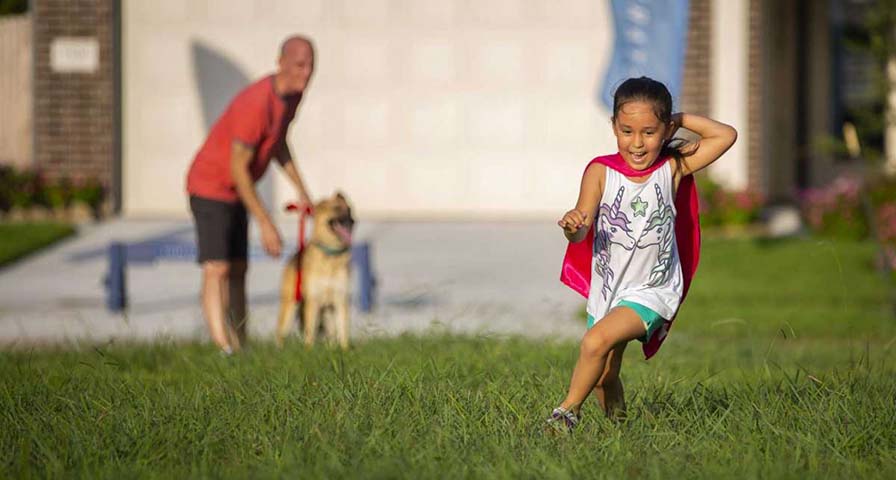Originally published Aug. 19, 2020 by Re/New Houston, a Houston Chronicle publication.
By Julie Garcia
Six-year-old Eliza Burke is starting first grade.
“But I used to be in kindergarten,” she says matter-of-factly as she put on her unicorn-emblazoned helmet and hops on her bicycle. Next to her is 4-year-old brother Ezra, ready to ride his bicycle, along with her dad, Ron, on his bike with baby Evan tucked in a carrier attached to the back.
Before they set off, Eliza says, “Wait, we need our capes!” She and her mom, Norma, run back inside the house.
Finally, the Burke family sets off for another evening ride, part of their at-home physical education regimen for the foreseeable future. Their neighborhood in unincorporated Harris County is enclosed, traffic is slow and the houses are full of families with children who are also starting their school year remotely.
PE doesn’t always mean wearing a superhero cape, but for the Burkes, it works. At least for now.
The kids attend elementary schools in Galena Park Independent School District, which announced the school year would start remotely; in-school classes will begin sometime after Labor Day. Clear Creek, Conroe, Montgomery, Magnolia, Texas City, Tomball and Fort Bend ISDs announced similar plans, while Katy and Cy-Fair ISDs planned to start in-person instruction this week for students who choose to learn on campus.
When her kindergarten year was cut short due to COVID-19, Eliza adapted quickly to distance learning. She likes reading most of all, she said, and is already reading short chapter books. She is also making her own comic book. She doesn’t play team sports yet, but she likes to practice soccer, baseball and basketball with her parents.
It’s been a strange summer for the Burkes. They have tried to find ways to keep the children entertained, educated and engaged while all of their normal haunts are closed. Now that school is starting, they know the kids will be in front of computer screens for most of the school day. But they want to make sure they’re getting exercise. A strong mind helps build a strong brain, Norma Burke says.
“They have so much energy; sometimes we just go on a walk around the neighborhood, and they try to catch dragonflies,” she says. “We also do exercise videos inside, but they like exercising outdoors more.”
The goal of physical education is to teach students how to have a healthy life as an adult, says Stasie Veinotte, lead PE teacher for primary education in Aldine ISD. It’s less about athletics, and more about nutrition and life skills.
Virtual learning started Aug. 17 for Aldine, and in-person classes are slated to start in mid-September. Parents can choose to send their children back to campus at that point but will have the option to keep them online until they feel safe.
Even though “gym class” is out, PE requirements haven’t changed, Veinotte says.
Using Schoology, an online platform similar to Google Classroom, teachers can provide learning materials, instructional videos and live class instruction. The platform is also how Veinotte and other Aldine PE teachers are reaching their students for virtual PE.
At the elementary level, the teachers can record themselves doing an exercise or dance and post it for the children to follow along at home; the kids can also send in their own submissions. At the high school level, students choose from team sports, individual sports, adventure and outdoor education, foundations in personal fitness and aerobic activities to receive their PE credits.
In both middle and high school, students are taught CPR and first aid skills. Because it’s virtual, they won’t be able to get certified yet, Veinotte says.
Each Aldine student starts a (fitness testing cycle) in third grade, which shows athletic growth over the school years until they graduate. Veinotte says it’s a way to see what programs work for which students and if their lessons are affecting childhood obesity.
The (fitness testing cycle) incorporates situps, pushups and a timed run called the “pacer test.” The test is a series of beeps where the kids run from one side of the gym to the other side until they quit. The point is to improve on the time from the beginning of the school year, she says.
Everything matters to PE teachers — from what the child ate for dinner the night before to activities they do outside of the school day. That won’t change because of the pandemic, she says.
Since Aldine ISD is a Title I school, many of the families are low-income and need assistance to buy computers or tablets to do at-home instruction. The school district has given away many laptops since the start of the pandemic, Veinotte says.
“All of our classroom teachers have taken surveys from their parents to make sure they have their devices, especially those with multiple students in the household,” she says. “We have tried to problem-solve with families to help them figure that out. Providing for our families is crucial so we can be successful for online learning, and our teachers have gone above and beyond to make sure we can connect with our kids.”
Seeking information about IHT's Online Physical Education program?





